





The Swedes from Arcona Yachts don't like being compared to X-Yachts anyway. And yet they have to face up to the confrontation right now. A major personnel matter has caused a stir: Niels Jeppesen, co-founder, face and figurehead of the X-Yachts brand and responsible for the design of all new models from Haderslev for almost 50 years, unexpectedly announced his move to a new client following the separation from X-Yachts in spring 2022. Jeppesen and his partner Ariadna Pons were to design a new 50-foot flagship for Arcona Yachts - for Arcona of all places, one of X-Yachts' main competitors.
This new liaison is likely to have caused quite a stir. Apparently, however, the parties are pretty much at peace with each other on the matter - at least that is what is being communicated. Jeppesen and Pons have been working as an independent duo from their design office in England for some time now. And the fact that the look of the new Arcona 50 now bears the typical signature of its designer Niels Jeppesen is probably more due to the nature of the situation than the competitive thinking of two brands that serve the same demand.
The Arcona 50 should do well in the Mediterranean
In fact, the Swedes' new flagship is a far cry from its direct competitor from Denmark, the X 4.9are quite similar both visually and conceptually - at least at first glance. Despite the supposedly many similarities, the differences lie in the details and are only really recognisable after a closer look. The parallels are not only to be found when comparing the Arcona with the X, but also in the comparison with the entire competitive environment. Particularly in the upmarket fast cruisers with a hull length of around 50 feet, the competitors present a strikingly homogeneous overall picture (see competition overview below).
With its latest flagship model, Arcona Yachts is now enriching this market segment as a new competitor. Until now, the yacht builders based in Gustavsberg near Stockholm have maintained a relatively narrow programme of fast, sporty performance cruisers between 34 and 46 feet in length, constructed by the now deceased designer Stefan Qviberg. The brand is still very successful on the regatta courses in the north and is also enjoying good demand in Germany, especially on the Baltic Sea. However, Arcona boats are rarely found further south, especially in the Mediterranean.
Urban Lagnéus, CEO of the Arcona Yachts shipyard, which now belongs to the same group of companies as Najad, hopes that this will now change with the new ship. As the brand's flagship, the new 50 is built much closer to the needs of the Mediterranean than its smaller sisters. The boat is designed to be more versatile, but is also less focussed on racing. This is particularly evident in the cockpit layout, which is also suitable for a small crew or family sailors. This means that the halyards, sheets and trim lines are led below deck and inside the cockpit coamings on two winches in front of the steering columns. An increasingly common solution on dedicated cruising yachts.
Front guest cockpit, rear work cockpit
The layout with the clear division of the guest cockpit forward and the working cockpit aft is also a common arrangement in the performance cruiser class, and the competing boats from X-Yachts and the Italian competitors are similarly structured. However, Arcona refrains from offering two versions for racing and cruising, such as Cantiere del Pardo for the Grand Soleil 48 Performance. Instead, the yacht builders have designed the layout very specifically so that both the helmsman on his own and an ambitious regatta crew can easily cope with the functions.

The designers have left enough space between the steering pillars and the cockpit thwarts so that the winches can be operated easily from the cockpit without cramping. However, the gap is at the expense of the dikes, which remain comparatively short with a length of just 1.74 metres. However, the winches on the rear cockpit coaming are very close together and also quite close to the halyard stoppers. Careful handling is therefore required during manoeuvres. And because it is not possible to crank the two winches at the same time, Arcona installs electric drives as standard for one of the two drums on each side.
Short rudders, but plenty of draught
Jeppesen & Pons have configured the Arcona 50 with double, relatively short rudder blades. This is particularly advantageous for courses with half winds or on a beam reach, which is the prime discipline for yachts of this type. In addition, a deep T-keel with a slim shaft and antimony-hardened lead bulb comes as standard. However, the draught of 2.95 metres is considerable and can be a hindrance in some sailing areas. For this reason, the keel is also available with a draught of 2.50 or 2.20 metres with correspondingly more ballast. The aluminium rig with three spreaders comes from the Danish manufacturer John Mast with rod shrouds and hydraulic tensioners for the backstay.
A carbon fibre rig with the same mast height is available as an option. According to Arcona Yachts' calculations, the weight saving is around 25 per cent, which is ultimately advantageous for better sea behaviour in waves. The shipyard does not offer a furling mast for the Arcona 50, but a furling boom from Mainfurl in Denmark is on the list of options. The test ship is also equipped with this.
The Arcona 50 sails very lively
For the trial run off La Rochelle in France, the conditions vary greatly, from almost calm to 4 Beaufort (12 knots) with some swell. The Arcona 50 gives an impressive demonstration of her abilities in all conditions. The powerful hull design by Jeppesen/Pons with the wide stern offers noticeably high dimensional stability. The boat sails stiffly and upright, which is particularly pleasant on long courses. Equipped with the optional overlapping genoa with hole points on the coachroof, the Swede also runs very well upwind. The tacking angle is 85 degrees or even slightly less.
It is also surprising how lively the chic ship moves and how quickly it returns to the set values after the manoeuvres. And this despite the fact that, with a displacement of just under 14 tonnes, it is not exactly one of the lightweights in comparison.
While rowing in windy conditions is a pleasure with a high fun factor, the steering feeling is almost completely absent in light winds, which is not unusual for designs with double rudder blades. This may also be due to the very high-quality but complex design of the Jefa steering system, which controls the rudder blades with two separate cables and couples the quadrants with a push rod. Although the system offers full redundancy in the event of a fault, it is somewhat sluggish even with more resistors.
The high-quality construction creates peace and stability
One thing is particularly noticeable below deck: the calmness underway and during manoeuvres. This is due to the perfect insulation with continuous inner shells, but also to the first-class workmanship and the high-quality construction of the hull and deck.
The Arcona 50 is built entirely in Arcona's new production facility in Uddevalla, while the hull is built entirely as a GRP sandwich construction using a vacuum infusion process with vinyl ester resin and a foam core. In addition, the shipyard laminates carbon fibre strips in the shrouds and keel suspension area and reinforces the floor assembly in the keel area with a steel frame.
Familiar layout with few options
The interior design with the owner's cabin forward, two guest cabins aft and two bathrooms, each with a separate shower area, corresponds to the class standard to which the concepts of all competitor boats are orientated with only minor deviations. After all, the feudal offerings are aimed exclusively at discerning owners who, at best, also invite friends to go sailing. In this respect, layouts with many cabins are not on the list of priorities.
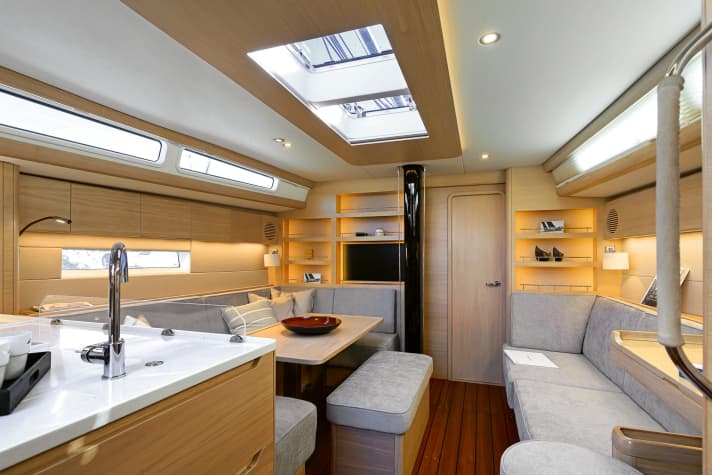
There is little variation in the layout of the aft cabins. Instead of a large, contiguous berth, two separate single berths are also possible here, which considerably simplifies access for double occupancy. Owners can also have the aft cabin on the starboard side converted into a large, internally accessible forecastle or have a workshop set up there. There are many different options here. In this case, the shipyard would cut out the inner shell in the area of the cockpit thwarts, making the large storage space accessible from the cockpit.
When designing the galley, the customer can choose between a closed U-shaped layout and an open arrangement with a free-standing cooking element and a direct connection to the seating area in the saloon.
Very high-quality interior fittings
The quality standard below deck is simply first class. Finishing with light-coloured oak, as in the construction number one, is an option. Arcona uses Khaya mahogany as standard, which is slightly darker and more reddish in colour. The customer also has the choice of flooring. The strap look as on the test boat is just one of many options. In addition to the impeccable, extremely high-quality workmanship of the interior elements in all areas, it is the many small details that are impressive, especially in the technical on-board installations. The components are perfectly accessible and are clearly and sensibly installed. The fuel and fresh water tanks are made of stainless steel and are fitted under the floorboards in the saloon.
However, the ventilation options on board could be better. The two hatches in the roof of the cabin superstructure are nice and large, but unfortunately the side windows cannot be opened. Cross-ventilation is only possible through the open companionway, especially in the saloon. The cabins and heads compartments, on the other hand, can be better ventilated.
The price tag hanging on the Arcona 50 causes general disillusionment. It states a base price of 1.04 million euros for the basic package ex shipyard, including 19 per cent VAT, but still without the sails, for which at least another 50,000 euros will have to be forked out. Even if the ship is beautifully built to a high standard and extensively equipped, that is a lot of money for a boat of this size and orientation.
The Arcona 50 achieved the Nomination for European Yacht of the Year 2024 made it. Whether the beautiful Swede can win the coveted award remains to be seen. The jury's decision will be announced at the boot trade fair in Düsseldorf, where the Arcona 50 will also be on show as a world premiere.
Measured values Arcona 50
Sailing performance
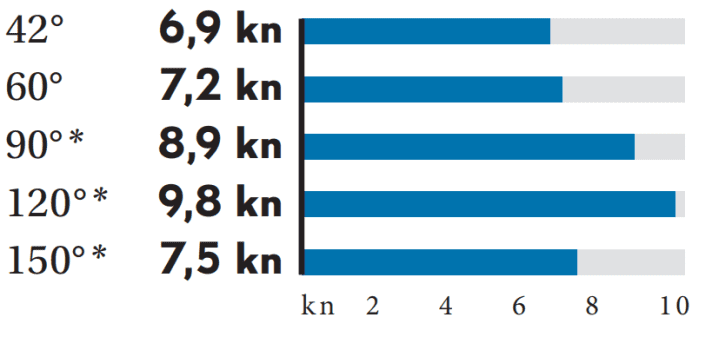
(without drift/current); wind speed: 10 to 12 kn (4 Bft), wave height: approx. 0.5 m
* with gennaker
Potential STZ* = 4.95

The Arcona 50 is already sufficiently rigged with the standard self-tacking jib
* Dimensionless number. Calculation: 2√S/3√V. The higher the value, the more sail area (S) the ship has in relation to the displacement (V)
Sound pressure
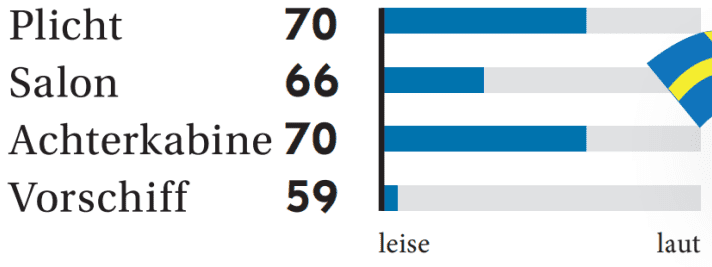
In dB(A), measured at cruising speed (80 % of maximum speed): 9.2 kn, 2,400 min -1
Cockpit dimensions

YACHT review Arcona 50
With its well thought-out concept, high quality and good standard of equipment, Arcona's new flagship can hold its own against strong and similarly orientated competitors. Only the high price can dampen the enthusiasm
Design and concept
- + High-quality construction
- + Clear alignment
- - Expensive in comparison
- - Short cockpit nozzles
Sailing performance and trim
- + High performance potential
- + Sails stiff and high on the wind
- + Perfect handling
- - Little feeling in light winds
Living and finishing quality
- + High fit-out standard
- + Sensible expansion options
- + Spacious berth dimensions
- - Restricted ventilation
Equipment and technology
- + Best basic equipment
- + Good trimmable mast
- + High-quality control system
- + Centrally installed tanks
Technical data Arcona 50

- CE design category: A
- Torso length: 14,99 m
- Total length: 15,80 m
- Waterline length: 13,98 m
- Width: 4,60 m
- Draught/alternative: 2,95/2,50/2,20 m
- Mast height above waterline: 24,08 m
- Theoretical torso speed: 9.1 kn
- Weight: 13,9 t
- Ballast/proportion: 4,6 t/33,1 %
- Mainsail: 86,0 m2
- Self-tacking jib (standard): 56,0 m²
- machine (Yanmar): 58 kW/80 hp
- Fuel tank: 385 l
- Fresh water tanks (3x): 125 litres each
- Holding tanks (2x): 52 litres each
- Batteries: 2x 225 Ah + 1x 75 Ah
Hull and deck construction
GRP sandwich with foam core and vinyl ester (vacuum infusion), stainless steel frame in the keel area
Equipment and prices
- Base price ex shipyard: 1.041.250 €
- Standard equipment included: Engine, sheets, railing, navigation lights, battery, compass, sails, cushions, galley/cooker, bilge pump, toilet, sailcloth, anchor with chain, fenders/mooring equipment, fire extinguisher, electric cooler, waste-holding tank with suction system
- For an extra charge: Sail (main and genoa) € 55,380, antifouling € 4,635, clear sailing handover € 6,275
- Price ready to sail*: 1.107.540 €
- Guarantee/against osmosis: 3/3 years
- Included in the price: Lead bomb antimony-hardened, sprayhood garage in the cabin superstructure, two cockpit tables, two electric winches, self-tacking rail, electrically folding bathing platform
* How the prices shown are defined can be found here!
Rig and sail
The three-saling aluminium mast comes from John Mast in Denmark. A carbon fibre rig from Axxon is also available as an option. The self-tacking jib is standard, a genoa is possible. The sails are not included in the basic price
Motorisation
Standard: Four-cylinder built-in diesel from Yanmar with 80 hp output (4JH80) with saildrive and three-blade folding propeller (Flex-o-fold). Optional upgrade to Yanmar 4JH100 with 100 hp output, bow and stern thruster from Sleipner
Hardware on deck
Deck fittings (blocks, clamps, rails) and winches (4 x 60.2) from Harken, halyard stoppers from Spinlock. High-quality basic equipment ex shipyard
Shipyard
Arcona Yachts AB, 134 40 Gustavsberg (Sweden); www.arconayachts.se
Distribution
AP Yachting, 24235 Laboe www.arconayachts.se/de
The competition in the premium segment
Grand Soleil 48 Performance
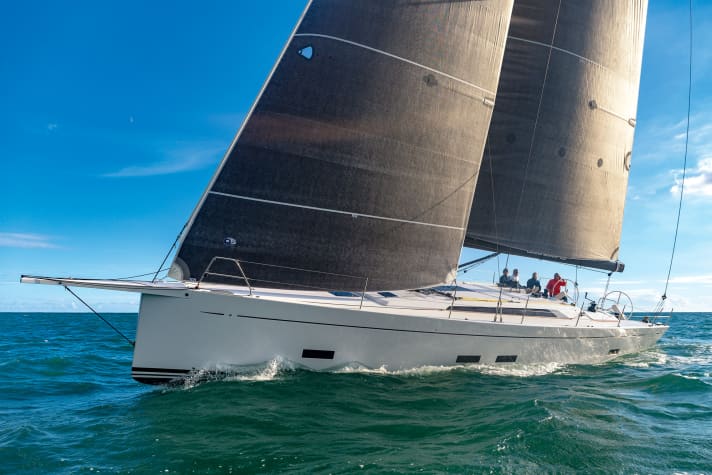
Powerful fast cruiser from Cantiere del Pardo in Italy. The boat is available with a choice of two cockpit layouts for cruising or racing. Very attractive both visually and in terms of price.
- Overall length 14.90 m
- Width 4.50 m
- Weight 12.1 tonnes
- from 677,110 euros
Solaris 50
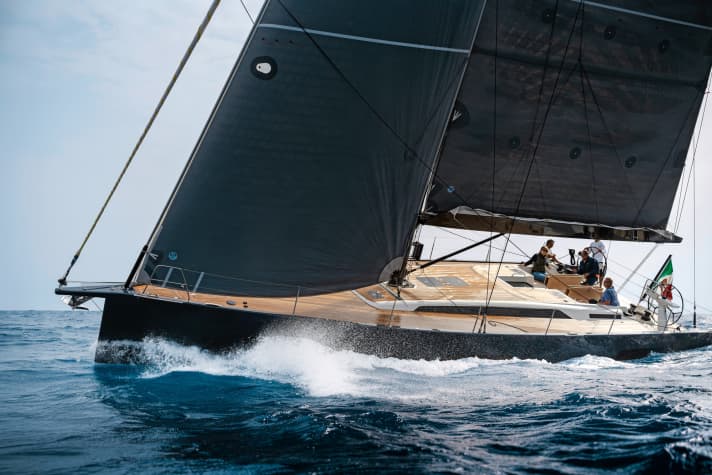
Visually exciting and very strong under sail. The beautiful competitor from the Solaris yacht builder also features many successful details on and below deck.
- Overall length 15.50 m
- Width 4.78 m
- Weight 15.9 tonnes
- from 779,450 euros
Swan 48
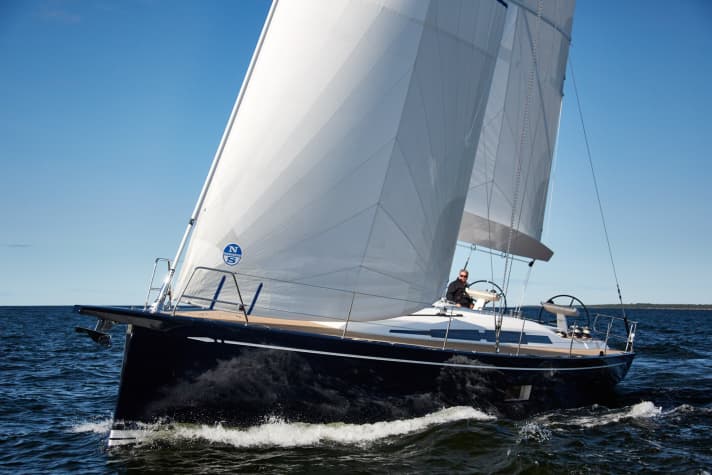
She is the smallest ship from the Nautor shipyard in Finland. The design by Germán Frers features beautiful, moderate hull lines and a sleek deck layout. Expensive in comparison.
- Overall length 14.78 m
- Width 4.59 m
- Weight 15.0 tonnes
- from 1,428,000 euros
X 4.9 MK II
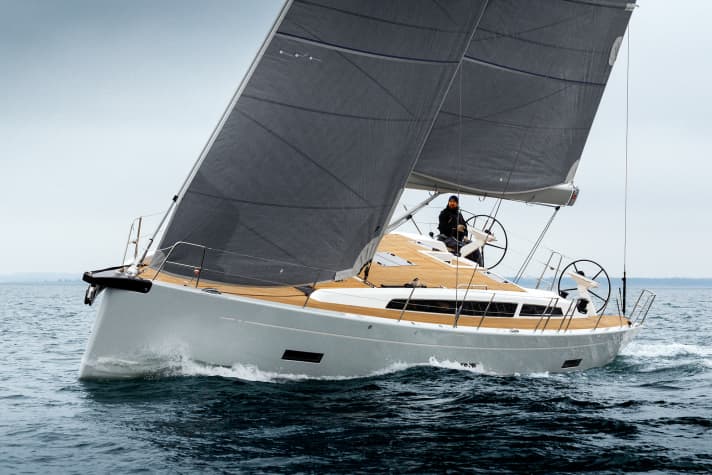
With her straightforward concept, the Danish yacht designed by Niels Jeppesen strikes a good compromise between fast cruiser and touring yacht. The revised MK II version is new.
- Overall length 14.65 m
- Width 4.49 m
- Weight 12.9 tonnes
- from 828,240 euros

